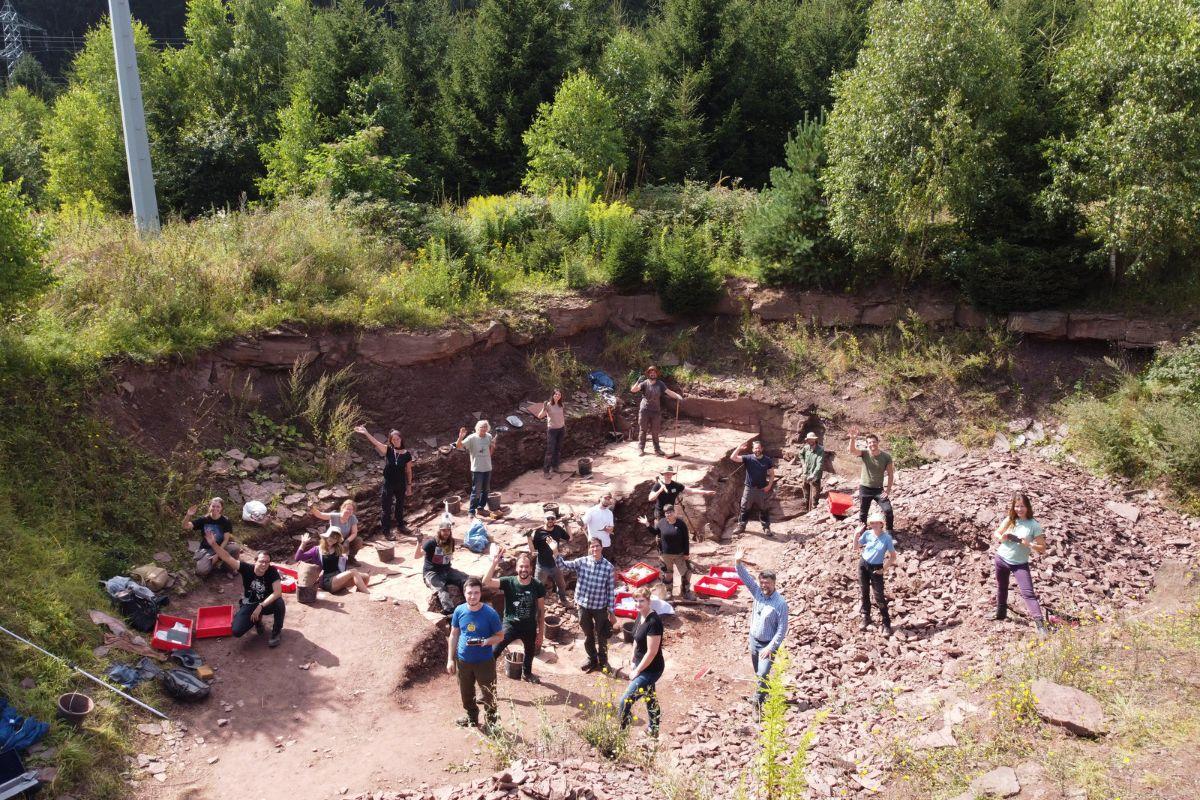Decades-long mystery finally solved: Bone turns out to be the pelvic bone of a terrestrial vertebrate
The 290-million-year-old Bromacker in the UNESCO Global Geopark Thuringia is one of the world's most important fossil sites and is currently being explored through an innovative, interdisciplinary and multimedia co-operation project. In 1974, the young geologist Thomas Martens, who had just completed his studies at the Freiberg Mining Academy, came across a find during excavations at the Bromacker that was to determine the course of his life. Decades later, the initially inconspicuous bone find turned out to be a valuable piece of the puzzle in prehistoric research: it was the previously unknown pelvis of an early terrestrial vertebrate. This autumn marks the fiftieth anniversary of this first fossil bone discovery at Bromacker.
An extraordinary discovery with scientific significance
Prior of the discovery of the first bone, it was mainly fossilised tracks of early terrestrial vertebrates that were known from the Bromacker site, but no bones. Until then, the scientific opinion was held that these Rotliegend rocks could not contain any bones apart from trace fossils. Martens recalls: "I was sure from the outset that what I could uncover in the rock must be bone remains. At the turn of the year 1974/75, I wrote to Prof A. H. Müller in Freiberg about the find. He replied: 'Thank you very much for telling me about the bone find. If this is true, it is very remarkable. Congratulations!' It is understandable that this assessment by my palaeontology professor inspired me to carry out further excavations at Bromacker – with great skeletal finds in the following years as part of decades of international and interdisciplinary research work."
Breakthrough with state-of-the-art 3D technologies
As part of the current BROMACKER research project, the enigmatic first bone find has now been digitally analysed and reconstructed at the Museum für Naturkunde Berlin using CT scanning. This allowed the fossilised bone to be digitally and non-destructively separated from the surrounding rock matrix and examined in detail from all sides for the first time. "I was particularly fascinated by the first bone find right from the start," says project manager Prof Jörg Fröbisch from the Museum für Naturkunde Berlin. "With the help of modern and CT-based 3D methods, we were able to isolate the bone, visualise it from all sides and compare it with other finds. The scales fell from our eyes and we immediately realised that it was the pelvis of a early terrestrial vertebrate dinosaur, most likely that of Dimetrodon, a distant relative of us mammals."
Dimetrodon teutonis: A new detail of the prehistoric dinosaur
The only species of the genus Dimetrodon that has been discovered at the Bromacker so far is Dimetrodon teutonis, a prehistoric relative of modern mammals and known for its distinctive dorsal sail. So far, only an isolated upper jaw, skeletal parts of a dorsal sail and extremities of this species have been found at the Bromacker. The discovery of the pelvic girdle complements the previous anatomical knowledge about this species and enables, for example, movement analyses of the animal's locomotion.
A unique site in the UNESCO Global Geopark Thuringia Inselsberg – Drei Gleichen
In addition to the Museum für Naturkunde Berlin, the Friedenstein Foundation Gotha, the Friedrich Schiller University Jena and the UNESCO Global Geopark Thuringia Inselsberg – Drei Gleichen are involved in the BROMACKER project. Sylvia Reyer-Rohde, Head of the Geopark Management Office, emphasises: "We are delighted to have such a unique site here in the UNESCO Geopark. Without the commitment of Thomas Martens, this special site would not have been discovered or researched and would not have achieved the international fame it enjoys today. Research at the Bromacker must continue. The fossil deposit is infinitely valuable for science and for the preservation of the UNESCO Geopark designation and thus for the region and for Thuringia."
Looking to the future: further excavations and new discoveries
The BROMACKER project started in summer 2020 and is funded by the Federal Ministry of Education and Research (BMBF). Science communication is a top priority in the project: The aim of the collaboration is to use the "Bromacker" fossil deposit to link research and knowledge transfer in such a way that a window into the early evolution of terrestrial vertebrates is opened to the public. The funding period for the BROMACKER project runs until summer 2025 and a final excavation in June 2025 promises further finds and insights. At the same time, discussions are already underway about how things could continue after the end of the project. The steadily increasing number of finds and the new discoveries at Bromacker make it clear that the biodiversity of this prehistoric ecosystem is far from being fully explored. Further promotion and institutionalisation of research in this region is essential to preserve this unique site as a source of knowledge about the evolution of early terrestrial vertebrates and as a public attraction for all generations. The team continues to excavate additional, spectacular finds to further explore and tell the story of the Bromacker and its prehistoric inhabitants.
